The one thing that remains constant with the ecommerce industry is that the landscape is always changing – and this year has been no exception.
Brands are navigating an ever-complex environment marked by economic uncertainty, shifting consumer behavior, and the ongoing demand for seamless omnichannel experiences. On top of this, sustainability and ethical practices have become increasingly important to consumers throughout 2024, raising the bar for brands to align with their shoppers’ values.
2024 has also witnessed a surge in competition in the ecommerce space, with an estimated 4.1 million live sites using Shopify right now. Yet only 2.86% of ecommerce website visits convert into a purchase.
So, when faced with increasing competition, growing consumer demands and dwindling sales conversions, how can brands possibly win in 2025? Dive into our expert predictions to uncover the specific approaches required to lead the way in the coming year.
Contents:
– Rewards get more rewarding: the rise of value-driven loyalty programs
– More than just Gen Z Purple
– Genuine engagement with your audience: micro-influencers and customer loyalty
– Building community and value beyond sales
– Planning your 2024 marketing strategy without depending on third party cookies
– A mobile app makes any retention strategy stronger and customers stickier
– Embrace the AI advantage
– Enhancing retention at a lower cost
– Social commerce … sell on social or get left behind
– Brands will lean-in to post-purchase survey data to drive revenue in 2024
– AR/VR = evolved engagement
– Leveraging AI to Boost Personalized Retention Efforts in 2024
– Final thoughts

Rewards get more rewarding: the rise of value-driven loyalty programs
Today’s customers are seeking more value than ever from their loyalty programs, and brands who don’t rethink their rewards could get left behind by these savvy shoppers. With the average American consumer participating in 16.7 customer loyalty programs, the question for 2024 becomes not ‘Should you have a loyalty program?’, but rather ‘How is your loyalty program better than the others?’.
While we know that customers seek value, it’s important to recognize that discounts aren’t the universal solution. A significant 66% of consumers say that their spending behavior is influenced by the opportunity to earn rewards. This emphasizes the necessity for brands to provide rewards that extend beyond just discounts; personalized, relevant, and valuable rewards tailored to the individual customer are crucial! By offering these kinds of rewards, you can win over your customers while also differentiating from your competitors.
So how can you make your rewards more rewarding? Here are our top tips for doing just that.
Free product rewards
Offering free products is a powerful way to reward your loyal customers while also introducing them to new items from your product line. This works particularly well for certain industries, like beauty and cosmetics, where members can try out new products to incorporate into their beauty routines.
You can see below how MAC allows their members to redeem their points on products. They offer flexibility in how members can use their rewards and also let them select products they actually want.
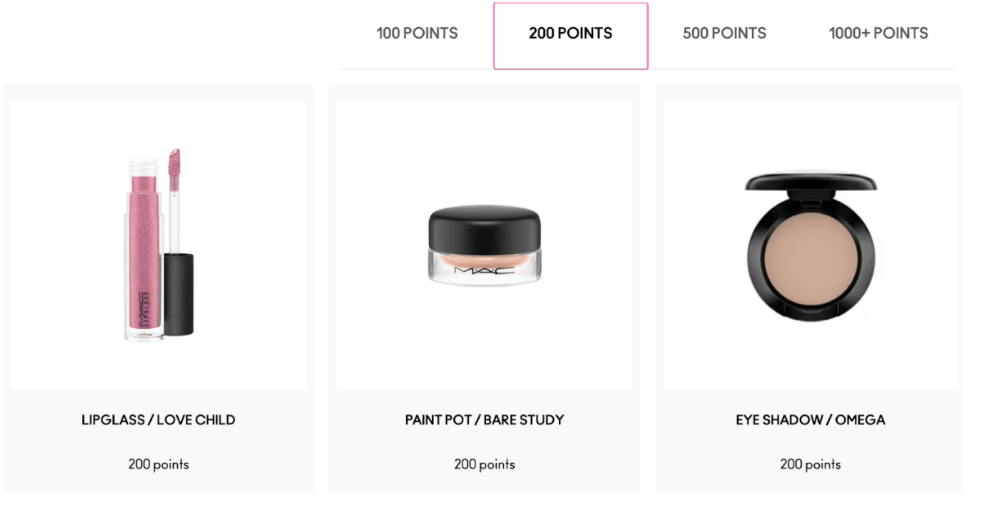
Eco-rewards/charitable rewards
In today’s environmentally conscious world, consumers increasingly seek brands that align with their values and demonstrate a commitment to sustainability. Offering eco or charitable rewards is a great way to tap into this growing segment of the market and offer genuine value to your customers who feel strongly about these causes.
Rewards could involve planting trees on their behalf, donating a portion of sales to environmental causes, or recovering ocean plastic like REN Clean Skincare do.
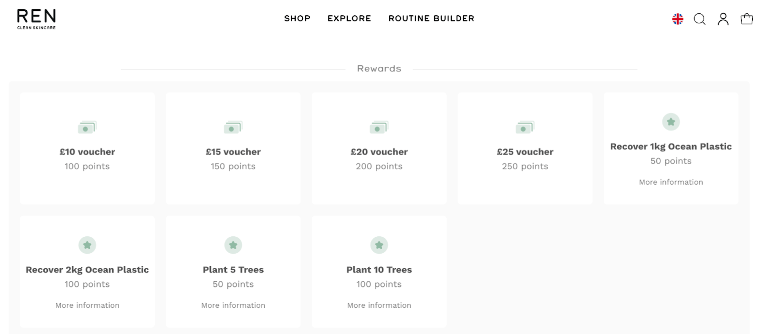
Giving customers the power to choose from a variety of rewards, including discounts, products, experiences, or charitable donations, allows them to select the rewards that best align with their individual preferences and needs. This personalized approach allows customers to choose the reward that they perceive to be the most valuable, so you really can’t go wrong with this catch-all option.

More than just Gen Z Purple
2024 will be the year of transformative change with Gen Z at the forefront. In 2024 I predict that brands will increasingly focus on crafting their ecommerce experiences for Gen Z consumers. As the first generation to grow up in the digital era, Gen Z’s expectations for the performance of e-commerce platforms have been steadily climbing. Beyond the mere transactional nature of online shopping, this generation, recognized as one of the most educated and diverse in modern history, is shaping the trajectory of online commerce with its distinct preferences and values.
In 2024, Gen Z consumers will place even greater emphasis on sustainability, ingredient transparency, and the impact of social media influencers when making purchasing decisions. Brands that align with these values will not only follow trends but address pivotal elements shaping the success of e-commerce brands in the coming year. Gen Z’s conscientious approach to environmental and ethical considerations is reshaping the ecommerce industry, and brands that align with these values are likely to gain significant traction.
As Gen Z establishes itself as the predominant consumer demographic, the focus on aesthetics is transcending surface-level considerations, such as the widely recognized ‘gen z purple.’ A term that not only gained popularity in 2023 but has also been chosen as Pantone’s color of the year. Brands are now prioritizing core functionalities such as speed, clarity, and transparency, which are emerging as pivotal components of online experiences, superseding visual appeal.
Our extensive site design and research at Vaan throughout this year has unearthed valuable insights into the intricacies of Gen Z’s preferences. We’ve discovered that this generation is not just interested in the superficial aspects of a product; the demographic is detail-oriented and values comprehensive information. Understanding what goes into a product, the reasons behind its formulation, and how to maximize its benefits are critical considerations for Gen Z buyers. As an example, while building out Rhode Skin, Hayley Bieber’s skincare site, our research led us to integrate an API-based ingredient data tool called Clear for Me, offering a transparent display of each ingredient highlighting why it’s an integral part of the product. This commitment to providing detailed and relevant information has yielded tangible results, with our team receiving unsolicited TikTok reviews, such as the one available here.
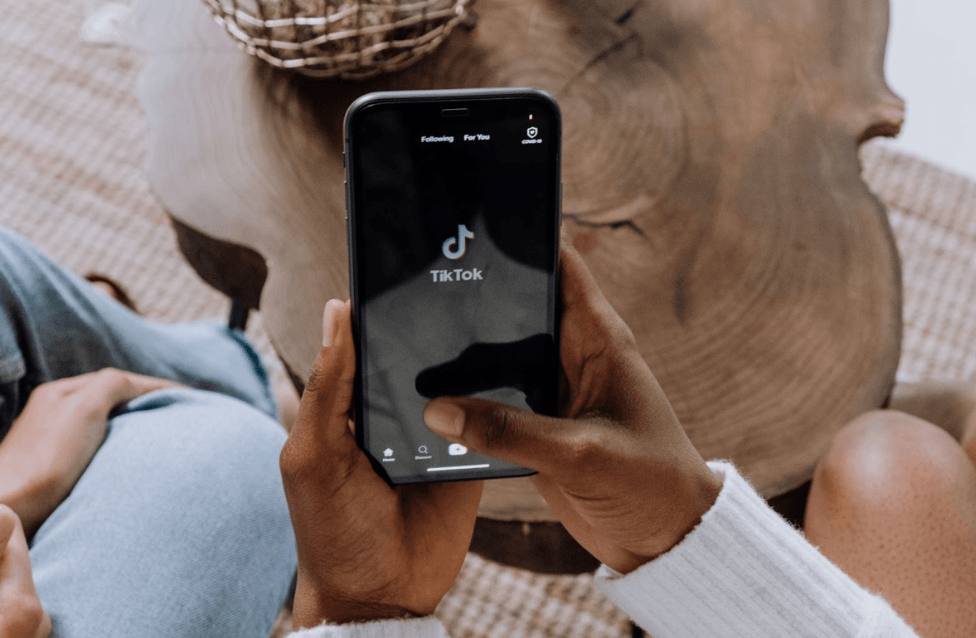
Navigating the dynamic between brand identity and conversion rate optimization (CRO) specific to Gen Z is an ongoing journey. Striking the right balance between cultivating a brand that resonates with the values of this generation and optimizing for conversion is a nuanced challenge. As we look ahead to 2024, the evolution of designing specifically for Gen Z emerges as a central focus for brands seeking sustained success in the ever-evolving e-commerce landscape.

Genuine engagement with your audience: micro-influencers and customer loyalty
A shift in online privacy protection requirements is becoming apparent as we get closer to 2024. Legislators, as well as big players in the space, are sending signals that customer data will no longer be as readily available as it was until now.
This poses a few very important questions to marketers, the most important being, “How do we target someone about whom we don’t know anything?”.
That’s where key concepts like genuine engagement, micro-influencers, and customer loyalty come into play.
Genuine engagement means looking at quality over quantity in your metrics. Does it really matter if 100 out of 1000 people clicked on your email, if they didn’t actually do anything meaningful after they did? Sure, your click rate needs to be above a certain threshold, but it doesn’t really contribute to your brand’s growth or your audience’s engagement.
In our opinion, the only real way to establish genuine connection (and thus elicit genuine engagement) between a brand and its audience is through intermediaries. Brands, essentially being a fictional amalgamation of people, content, ideas, and products (in no particular order), can only “reach out” in a simulated way. Enter – micro-influencers!
The main benefit of micro-influencers over other kinds of influencers, and other kinds of D2C marketing, is the fact that their size allows them to focus more on their audience, custom-tailor their content, and incite meaningful conversations about your brand and your products.

How many times have you found yourself engaging with a forum before you made a decision to buy a product or subscribe to a service? Micro-influencers allow you to do just that in a systematic way with a planned budget and a clear set of performance indicators.
After the micro-influencers have done their thing, and connected you with your audience, you then have to put all of the data you’ve been willingly given to good use. From an email marketing perspective, this is when you would seriously consider developing your customer loyalty platform, turning your newly generated customers into evangelists and even micro-influencers themselves.
The silver thread connecting all of these different concepts is privacy, or in a more general sense, data ownership. If the customers don’t trust an ethereal concept, such as a “brand”, enough to give them their data, then your intermediaries, micro-influencers and customer loyalty advocates, will do the trick. That’s why we think this will be the most interesting trend of 2024.

Building community and value beyond sales
In an era where major brands launch Black Friday discounts as early as September, smaller brands cannot rely solely on price competition. Offering 30% off for an entire quarter is simply not viable. Instead, medium-sized brands should focus on standing out through campaigns that resonate with their customers’ values and ongoing conversations.
Consider loyalty programs with a community impact or those that integrate social conversations, growing alongside your customer base. Brands must recognize that the needs of their best customers evolve over time. It’s crucial to engage and reward customers at different stages of their lives, aligning with their changing needs. A prime example is Knix, which adeptly transitioned from targeting millennials in their reproductive years to addressing perimenopause issues, thus evolving with their clientele. Their campaigns focus on fostering community and addressing challenging topics, with their products complementing these initiatives rather than being the sole focus.
Future loyalty programs are likely to emphasize social change and genuine community building over mere transactional benefits like coupons. Brands could innovate by rewarding customers for engaging with their content, such as visiting blogs or community portals. This approach, focusing on meaningful interactions rather than just sales, is poised to attract venture capital interest in the brands of tomorrow.

Planning your 2024 marketing strategy without depending on third party cookies
Third-party cookies are going away in 2024! With rising concerns about privacy, tech platforms like Google have been phasing out third-party cookies for the last couple of years, with Chrome shutting down tracking in August 2024. ICYDK, Third-party cookies are created by third-party domains other than the website that a user is visiting, and they are used to track user behavior and gather data for targeted advertising.
While this might feel a little scary as a concept, if we plan and adjust our strategies thoughtfully, we can minimize the impact this will have on your business. This means how we spend our marketing budget and its perceived impact will need to change.
For one, we recommend rethinking top-of-funnel spending. A good way to think of this change is that marketing is a casino, and with third-party cookies, you were counting cards, and now (like in an actual casino), you’re no longer able to. Gambling on ads just became riskier; it’s still effective, but you need to cast a wider net to guarantee a return. This brings back the return of vanity metrics like impressions and brand awareness, where starting to spend on PR, out-of-home marketing, and connected TV will suddenly seem more enticing.
Secondly, investing in your retention marketing is just going to make more sense. Those are the customers you have data on and can create thorough marketing experiences for. Why do customers keep choosing your brand over others? Because you built a community and an experience they can’t get anywhere else. You can do this with strong loyalty programs (shoutout to LoyaltyLion) that leave customers feeling celebrated with exclusive perks and rewards. Another is personalization with smart banners and interest-based journeys based on their behavior, giving them a customized email and SMS experience.

And lastly is working with tech partners that support conversion as well as use first-party data to help you optimize. The ones that we’ve been recommending to all of our clients are Because and Black Crow AI. Because – the platform – turns every step of your website journey into a dynamic conversion machine and increases conversion by 33%. Using badges, in-cart messaging, and banners, every element is dynamic to your customer and enhances the UX to guide users down the path to the purchase journey. Rounding it out, Black Crow AI supercharges your marketing strategy with the power of AI prediction and Identity Resolution. Used in tandem with retargeting flows, this can Increase revenue by 20% by identifying every visitor and engaging with them more effectively.

A mobile app makes any retention strategy stronger and customers stickier
For 2024, brands are focusing on improving CX to drive retention. One lever to expand reach & engagement, drive revenue, and diversify acquisition strategies is by adding a mobile app to your marketing mix.
An app elevates your mobile CX because it’s the smoothest way to shop on mobile and the best way to engage with your customers where they are. A mobile app adds legitimacy to your brand presence, helping you to stand out with features like unlimited push notifications, instant page loading, one-click checkout, real estate on your consumer’s phone, and more—so customers purchase more often and spend more. App users have proven they’re more die-hard fans, with higher conversion rates, revenue per session, and lifetime value than mobile and desktop web.
Many smart brands designate the mobile app for their community of VIP customers by making it a hub of app exclusives, and content, and as a valuable communication channel for updates. Ultimately mobile app customers feel special, won’t churn, spend more, and stay forever. As a result, the mobile app drives loyalty and revenue for ecommerce merchants because it captures customers that spend more in-app, more often and longer.
BÉIS saw an app as an opportunity to diversify, scale, and boost customer loyalty. With the goal of increasing customer loyalty and retention, the app delivered and keeps customers spending 19% more (AOV) with its mobile app, and sees a 67% higher app conversion rate vs mobile website.
For True Classic, an app is an awesome opportunity to combat skyrocketing acquisition costs with even higher LTV. Making the app the center of the retention stack allows the True Classic team to personalize the CX and remove friction to convert. The brand sees a 200% higher conversion rate in app vs mobile web and 91.5% retention rates on the app.
A mobile app is a trend for a reason, and more brands are hopping on the train. From fashion, beauty, CPG to home goods — the value of offering a mobile app to customers is critical. Considering Gen Z is emerging as a purchasing powerhouse and is reshaping ecommerce, it’s no surprise that 67% plan to do their 2023 BFCM shopping in mobile apps.

Embrace the AI advantage
AI isn’t just a fleeting trend. It’s rapidly transforming marketing workflows, and we’re only just starting to tap into its potential to drive even more personalized marketing. As an e-commerce marketer, you need to embrace the power of AI to stay ahead in the ever-evolving digital landscape.
Imagine delivering tailored messages to each customer based on their individual behaviors. This level of personalization has been a dream for marketers, but now AI is making it a reality. You won’t need to rely on data scientists (or try to become one yourself) to make sense of your customer data. Instead, AI solutions can help you make sense of a vast amount of behavioral data, so you can deliver the right experience to the right consumer, at the right time.
Using predictive AI, you can spot key trends, identify high-value customers, or determine when a shopper is likely to make a purchase. From there, you’ll be able to send the right incentives (and even unlock progressive offers) based on your own data, maximizing your ROI. For example, you can offer a new subscriber $10 off on their first purchase, knowing it’s the offer that’s likely to convert them. As they make follow-up purchases, you can offer $7 and $5 off, since you know their lifetime value has increased significantly.
Making this vision a reality in 2024 will mean investing in the right tools that will empower your team to harness the potential of AI and extract valuable insights without the need for deep technical expertise.
The promise of truly 1:1 marketing is becoming a lot more attainable. With AI, you can deliver tailored experiences to your customers, improve your campaigns, and drive better results. Embrace the power of AI and position yourself at the forefront of the new frontier of marketing in 2024.

Enhancing retention at a lower cost
For a very long time, brands and marketers were spoiled with low customer acquisition costs and a strong economy, where brands focused on extreme growth regardless of the cost, even if the return was negative.
To put it in perspective and show you some numbers: as of 2023, we are generally losing $29 on every new customer we acquire, whereas pre-pandemic in 2019, this number was as low as $9.
My prediction for 2024 is that brands will reduce their acquisition budgets and invest more heavily in customer retention.
Here’s what brands are doing and will be doing more of in 2024:
1. In-depth analysis of their customers using generative AI, RFM analysis, cohort analysis, etc. In short, the brand will be investing to understand and identify who their ‘whales’ are, those bringing in 80% of the revenue. They will focus on converting more of their existing customers into ‘whales’ and keeping them longer with the brand.
2. Brands will strategize using tools and tactics to keep customers shopping with them rather than with competitors. This could include a loyalty program, a community, exclusive educational resources like courses for customers, store credit versus discounting, and brand subscriptions similar to Amazon Prime, which provide additional benefits. In short, all these programs are designed to identify and closely tie the customer to the brand.
3. Brands will be consolidating marketing tools to save money and create an omnichannel, continuous journey for customers.
4. Brands will switch their focus from desktop to a mobile-first experience. According to DataReportal, 56% of all web traffic comes from mobile in 2023, a significant increase from 37% in 2011. As we can see, customers prefer mobile, so we need to optimize not only the store but the experience in general. In fact, our agency Flowium back in 2021 switched to designing and optimizing emails for mobile first and desktop secondary.
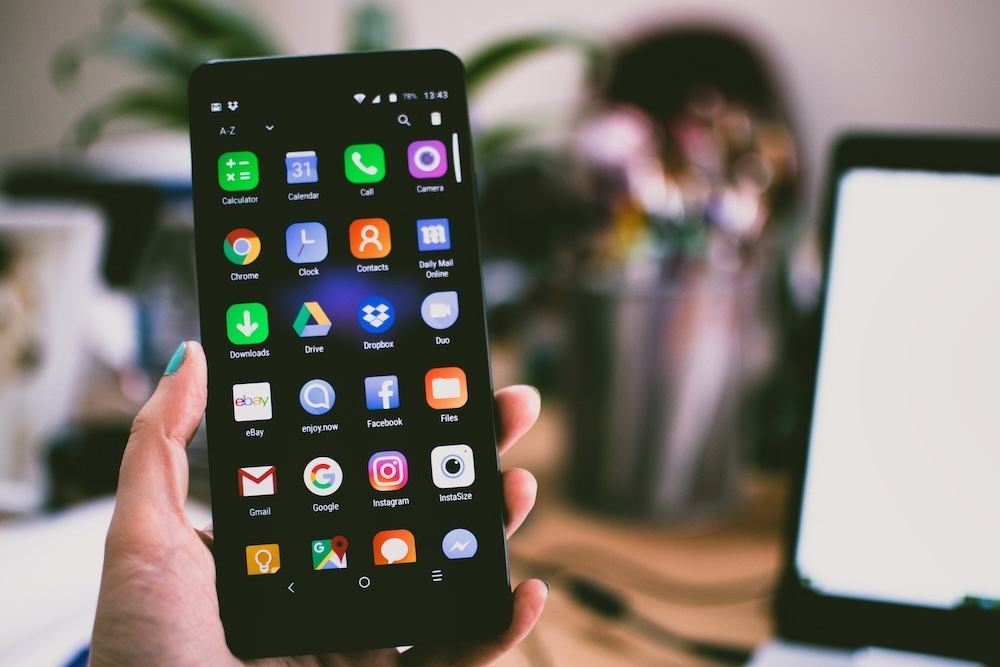
5. Brands will look for ways to replace some costs with AI tools or tools that can perform the same functions but for pennies on the dollar.
These predictions are something we see already starting to happen in the second half of 2023, and I believe they will continue to develop in 2024.

Social commerce … sell on social or get left behind
In-app purchases have exploded in the past year with the likes of TikTok and other social media platforms pushing creators to sell on their platforms. With consumers having less time and always looking for the most convenient way to purchase goods, in-app purchases are becoming a more popular way to order as there is no need for them to even switch to a different website/app to buy.
We also predict that as users shop more via their favourite influencers it’s crucial to make it easy for those leads to come onto your website and find the items they have seen on social media. Creating sections on your site dedicated to ‘As seen on social’ or even just having a social tag on the items shown via social media can greatly improve conversion on your site.

Brands will lean-in to post-purchase survey data to drive revenue in 2024
We’re fans of direct communication here at Triple Whale. There’s no better way to learn from your customers than to ask them what you need to know.
Brands who know where their customers are coming from can be more confident in how they spend their marketing dollars.
And, they are.
We compared a cohort of our customers who have a Post-Purchase Survey installed (1987 stores) to stores without a PPS (4454 stores), and the numbers don’t lie.

Stores with PPS are spending less money on acquiring new customers. Why? Because they understand which ads are converting, and they can put more money behind the ones that do.
Additionally, the in-platform data doesn’t always tell the whole story, since conversions are often attributed to a click-related event. MaryRuth’s discovered that their return-on-ad-spend (ROAS) for TikTok was 900% higher than previously reported when Triple Whale’s Total Impact Model gave proper credit to customers who reported they saw a TikTok ad. Having a Post-Purchase Survey installed allows you to confidently understand where your customers came from, and double-down on those revenue generating ad platforms instead of wasting coin on lesser ones.
We predict that brands will continue to integrate and utilize Post-Purchase Survey data because it helps them spend more efficiently, and more efficient spend is better for driving revenue in 2024.

AR/VR = evolved engagement
VR/AR and zero/first-party data go hand in hand in 2024 because they are both centered on creating a personalized experience for a consumer. With VR/AR there is a world presented where a consumer can feel like they are already seeing the benefits in action of the product. This visual creates an environment for a consumer to overcome many objections at once, creating FOMO, and a tangible attachment to products.
When consumers can address and overcome their own objections, you’ll see a change in shopping behavior allowing you to shift your marketing from a reactive stance (objection handling) to a proactive one (experience it for yourself). Now, mix in the rise of zero and first-party data capture/use, and you’re on your way to a truly 1:1 shopping experience that builds trust along the purchasing journey through relevance and interest.
With personalization via VR/AR and trust building with zero and first party data we see a magical opportunity for conversions and meaningful engagement to be explored AND scaled. When you consider how many objections come with online shopping it seems obvious that a website would be there to help you shop and not just show you a product.
In general, shopping online will require more interactivity for long-term growth of a relationship between a brand and consumer, think private shopper mode enabled! Over the years we have been slowly but surely creating more engaging online shopping experiences as a result of public demand.
A customer can be swayed or dismayed by a shopping experience, and that’s why we will see AR/VR emerge to provide real-time and “in their hands” experiences.
Introducing AR/VR, live chat, and personal shoppers will yield higher engagement and conversion rates. But before even getting to the high-tech approach, so many brands could reap the same benefits through a better understanding of their audience and leveraging visitor profiles to create similarly personalized experiences reacting in real-time to their behavior.

Leveraging AI to Boost Personalized Retention Efforts in 2024
Written by Kyle Panganiban, Partner Enablement Manager
2024 eCommerce trend:
Artificial intelligence (AI) will continue to be a valuable tool that reshapes the eCommerce landscape, influencing tailored customer experiences and optimizing backend processes. As AI becomes more popular and readily available, there will be a shift towards more creative customer retention strategies that emphasize personalization over simple discount offers as brands seek a more sustainable approach to fostering customer relationships.
With 71% of consumers now expecting brands to deliver a personalized shopping experience, the need for a customer-focused strategy is clear. When consumers are evaluating which brands to go back to, personalization becomes even more important, as 78% of consumers are more likely to make repeat purchases from companies that do personalize.
AI can prove to be an effective tool that simplifies the personalization process and increases customer retention rates. When using a personalization platform, like Rebuy, brands can utilize AI-powered and data-driven rulesets that help to surface relevant content, based on customer preferences.
Reorder Landing Pages
One solution that can be implemented alongside AI to increase customer retention is Reorder Landing Pages, which can be included in post-purchase efforts such as email and SMS campaigns.
Reorder Landing Pages make it easy for customers to purchase the same product(s) that they bought in their last order by surfacing a custom landing page, complete with a pre-filled cart that contains the item(s) from the previous order.
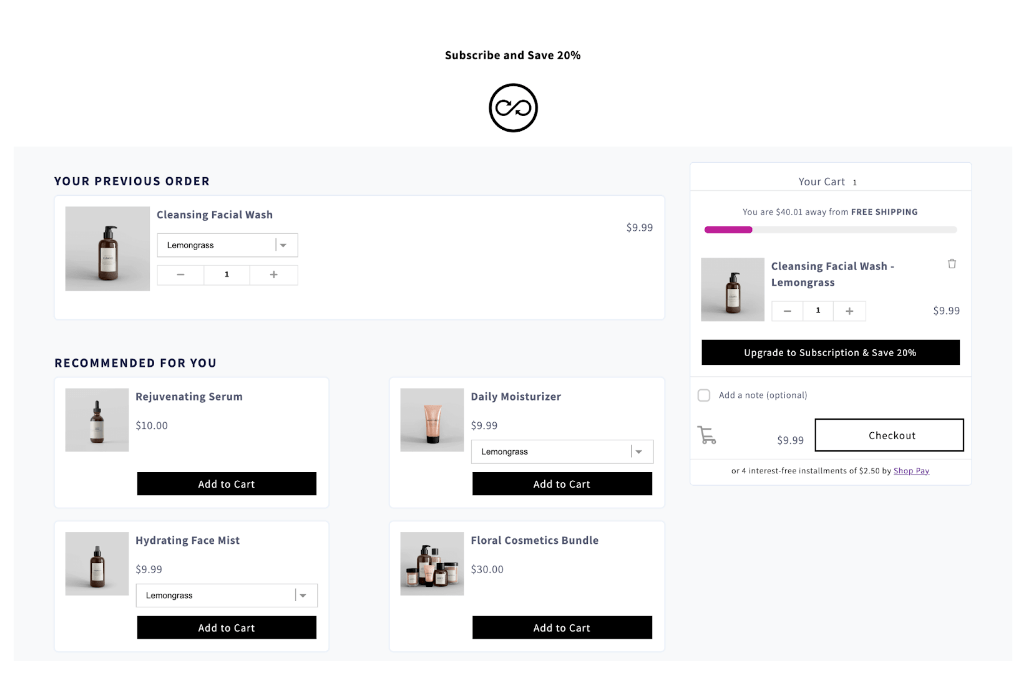
These custom-built landing pages also feature several AI-powered components that help drive reorders with returning customers:
- Dynamic banner messaging
- Data-driven product recommendations
- Free shipping progress bar
AI can dictate the behaviors of each landing page component based on pre-defined rules that are configured by the brand. For example, if a returning customer bought items from Collection A and Collection D, the landing page’s product recommendations could surface additional items from those two collections to try to incentivize additional add-to-cart actions.
This would be valuable for the customer because they would be able to seamlessly reorder the items they already know and love, and purchase new products that they might not have discovered without the personalized product recommendations. In turn, the brand realizes an increase in AOV and conversion rate.
Personalizing the Post-Purchase Customer Experience
The integration of AI is pivotal for brands aiming to improve retention rates and meet evolving customer expectations in 2024. The demand for tailored experiences is evident, and AI can serve as an effective tool in simplifying personalization efforts.
One piece of advice for merchants:
Personalize the entire, omnichannel customer experience to maximize key eCommerce metrics such as conversion rate, AOV, and customer LTV. AI-powered and data-driven product offers can help to create a tailored customer journey that keeps shoppers coming back. Instead of only surfacing traditional discount offers, show your customers that you acknowledge and understand their shopping preferences by providing personalized product recommendations in the post-purchase experience.
Looking back at the year so far
The second half of the year is fast approaching, so it’s time to look back and see what other ecommerce trends have come to light in H1, and what the second half of the year might hold.
We got the lowdown from some of the biggest technology providers in the Shopify space – you can watch the full webinar here, or keep reading to get their thoughts on the year so far.
The challenges we’ve faced so far
Google and Yahoo changes hit email hard – LoyaltyLion
Many ecommerce brands have found that the regulation changes that Google and Yahoo introduced to email earlier this year have impacted email performance. More brands still may not have realized that their emails are not reaching customer inboxes. This is a challenge but also an opportunity to do better email marketing.
To negate the impact of this trend, LoyaltyLion believes that brands will need to work harder to collect zero-party data they can use to provide personalized emails that keep clickthrough rates high and unsubscribe rates low – all positive signals to send to email providers. We expect to see more brands using their loyalty programs to collect that data, whether that’s via points for quizzes and surveys or gathering qualitative feedback from focus groups for top tier program members.
Disconnected experiences harm customer engagement – JustUno
Too often, we’re leaving shoppers disappointed with disconnected experiences across multiple engagement channels. Your customers may shop online, in-store or via social and you need to meet them wherever they are. Too often we fail to recognize them and serve up a relevant experience, limiting the opportunity to increase LTV at the same time. We need to get better at targeting behaviors and personalizing experiences as they’re happening on the website, rather than waiting until we send emails or SMS messages later.
JustUno believe that it’s time to start offering different customer experiences depending on where customers have come from, where they last shopped, and whether they are new or returning visitors. Brands need to begin embracing and reacting to more real-time targeting opportunities, for example cart or browser abandonment. They also need to get more creative with testing around those opportunities.
Dedicating time to deliverability – Klaviyo
As well as highlighting poor personalization, the ‘Yahoogle’ changes in email also highlighted technical challenges. Brands had to rush to reach compliance, setting up DMARCs, changing sending volumes and patterns and checking for dedicated sender IPs. Having a well-rated IP and great deliverability is now more important than ever – a better sender reputation will drive a better ROI from email marketing.
For the rest of 2024, Klaviyo believes that AI will become increasingly hype rather than hot air. Brands should tap into all the data available, using it to test and automate communications according to individual buying behaviors rather than trends.
Threats to ad performance – Triple Whale
The first half of 2024 has seen several shifts in digital marketing. The 2024 core algorithm update cracked down on poor quality content which in turn impacted organic traffic and left brands with a greater reliance on paid while SEO performance was repaired. Changes to Meta Ads Manager also left marketers with a learning curve to navigate, also temporarily affecting ad performance. The challenges of cookie depreciation and TikTok being banned in the US still linger as we head into H2.
Triple Whale believes that in H2, marketers should make the most of the market expansion opportunities that TikTok offers while they still can. They also believe that increased customer confidence and spending, combined with the improved customer experience that the digital changes in H1 drove will result in a lucrative second half of the year for ecommerce brands.
Failure to take context clues – Gorgias
Personalization has gone a little wrong in the fist half of 2024, with brands using aggressive discounting strategies that erode sales and change their perceived value. Brands are using discounts to try and solve customer engagement and personalization challenges, rather than taking context clues and offering discounts in response to actions they take or signals they give.
For Gorgias, the second half of the year is about frictionless experiences. A combination of customization and convenience – particularly across mobile experiences and the checkout – will be key to building better customer relationships. Brands should also think outside of financial offers for the holiday sales, leveraging alternatives such as early access to sales and other alternatives to discounts.
Supply chains remain disrupted – Shipbob
If you thought supply chain disruption were a thing of the past, think again. It’s impossible to predict when unexpected issues will arise and the first half of 2024 has shown that brands need to be more proactive and flexible, redistributing inventory to multiple warehouse locations in order to negate the impact of unexpected disruptions. This will also help to deliver on faster shipping expectations.
Shipbob believe that the priority for the second half of the year is personalizing the final part of the shopping experience. Brands should be doing what they can to over communicate post-purchase, make really memorable unboxing experiences, and use automated inventory alerts to inform customers when items are back in stock.
Final thoughts
With retention dominating the ecommerce landscape like never before in 2024, now is the time to start making the necessary changes that will give you a head start! To sum up, here are some of the goals you need to be shooting for:
- Introducing more meaningful and valuable rewards in your loyalty program
- Building stronger relationships with micro-influencers
- Prioritizing your mobile app experience
- Embracing the opportunities that AI provides
- Using social media as a platform to sell
Thinking of investing in loyalty for 2024? Our ROI calculator will help you determine how successful your loyalty strategy will be.
Ecommerce Trends 2024

Want a glimpse into what the world of ecommerce has in store in 2024? Join us on Wednesday 24th Jan at 11am PT, 2pm ET, 7pm BST ✨





